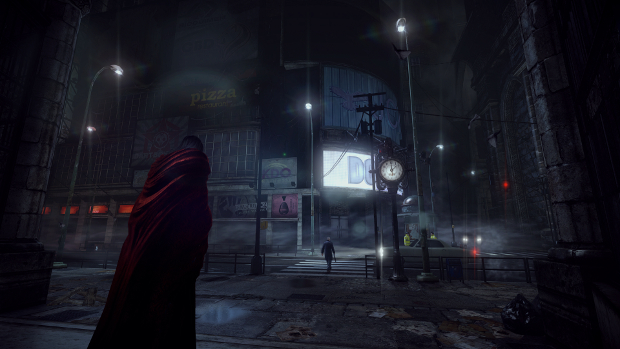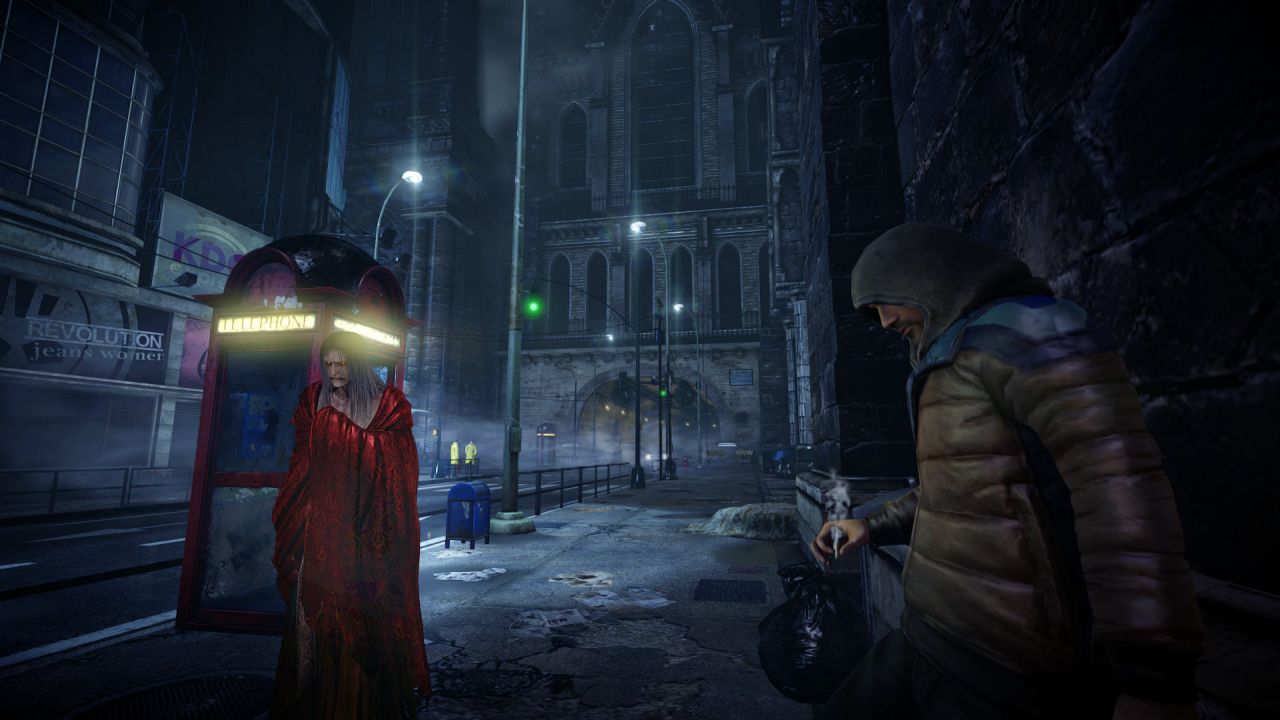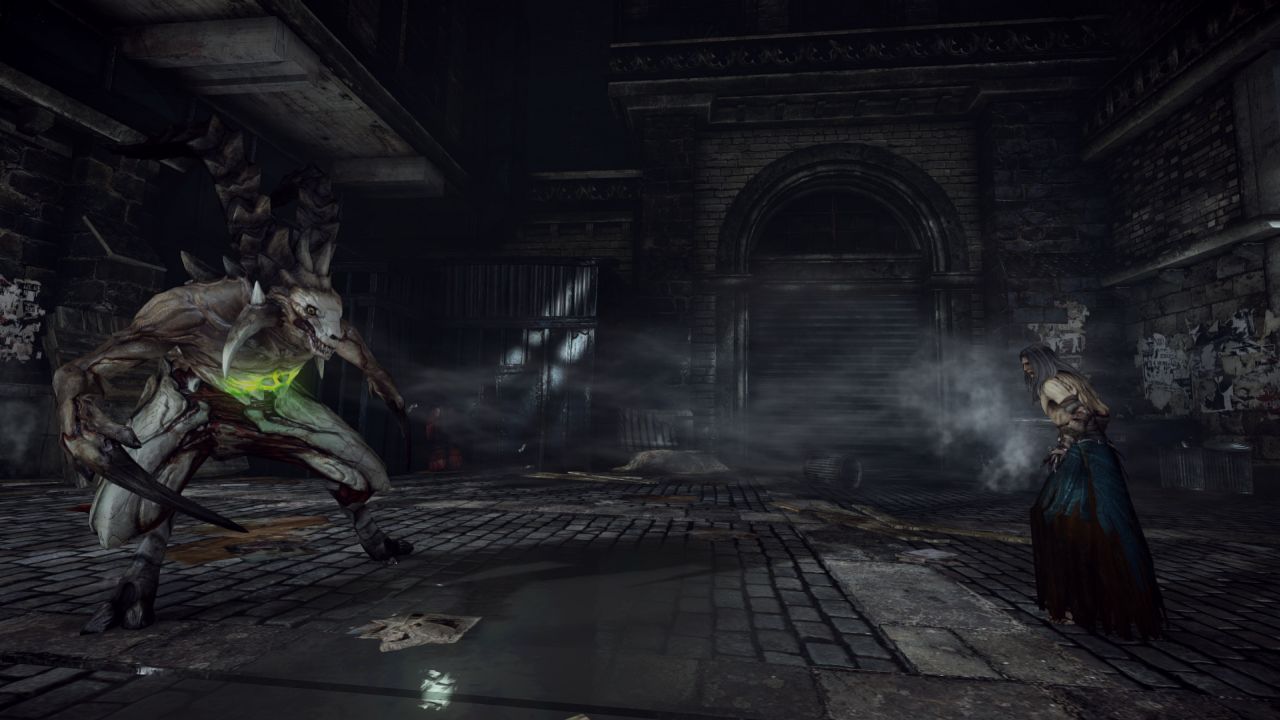
Last month I was made into a very happy little boy scout when Konami invited me to check out a near-final build of Castlevania: Lords of Shadow 2. I got to play the first three hours of the game. We were also shown a part toward the halfway mark in the game by Dave Cox, which is where we’re going to start this preview.
This presentation gave us a look at one of the game’s puzzle sequences, followed by a major boss fight against the Toy Maker, who you may remember from Mirror of Fate. It was neat because even the puzzle segment itself revolved around the Toy Maker, showing us his origin and history all while having us solve the physical puzzles needed to retrieve his heart. The puzzle isn’t unlike what you’ve come to expect from the original Lords of Shadow and Mirror of Fate, but what makes this particular one a standout is how it also weaves storytelling into it. I sure hope we get more puzzles like that!
After obtaining the Toy Maker’s heart and attempting to get a shard of the mirror of fate from him after reviving him, Gabriel then goes up against the man himself, who becomes possessed by the castle’s blood (more on this later). The fight is awesome and Toy Maker turns into a mechanical monster that’s relentless in its attacks against Dracula. It appeared to be a challenging bout, where players can’t just rely on mashing buttons repeatedly. This looks like it’s going to be a huge moment in the game’s plot, and one where the mirror of fate will once again come into play. Gabriel seeks it in his quest. He gets the piece from Toy Maker after he returns to his senses. Or, rather, after you beat the holy hell out of him enough to make him go back to normal. Toy Maker is already shaping up to be a rather tragic figure on his own, and not just a man responsible for some sadistic traps and mechanical splicing of monsters, gleefully rocking back and forth on a unicycle. And the best part is, almost all of the bosses will mirror Gabriel in that they too will have tragic back stories.

After this presentation we got to play the opening parts of the game. The first three to four hours to be exact. This started with the segment available in the demo that’s packaged with the Lords of Shadow Collection and Mirror of Fate HD. After fighting waves of Brotherhood knights, and being introduced to the void sword and chaos claws, essentially the game’s new form of light/dark magic, we take on one of the game’s Titan bosses that’s accompanied by another mini-boss (a Brotherhood paladin). The battle is exhilarating, with daredevil platforming brought into the mix as Gabriel climbs his way to the top of the mechanical monstrosity while also fighting hordes of knights on the boss itself. All this is happening while the towering foe is trying to destroy the castle. I haven’t been more thrilled with an opening boss battle since Poseidon in God of War III’s unforgettable intro.
Once the segment from the demo ends, we get to finish the fight against the gold-armored, Symphony of the Night line spewing Brotherhood paladin. It reminded me a lot of the fight with Pan from the first game. The scenery for this fight is also quite awesome, what with knights littering the ground everywhere, and pieces of the demolished Titan. After the boss go down we get to see a scene from the game’ s debut trailer, where Alucard shows up, sword in hand, to confront his father. This scene leads the way to the modern-day storyline after a pretty lengthy and convenient cinematic that serves as a recap for fans and a summarized version of the previous two games for new players. I’ve played both the original Lords of Shadow and Mirror of Fate way too many times, but I was still compelled by this nifty sum up of the entire lore up until the final part of the trilogy.
Then we’re treated to Gabriel’s awakening in the modern setting. With nice little flashbacks to the first game’s brilliant epilogue. After the cut scene we get to go outside of Gabriel’s safe haven and experience the open-world modern city MercurySteam has created for players. Dracula, in his withered state, covered in a red cloak looks quite creepy and exactly how I always envision him in my mind. I remember as soon as I got control over Dracula, the first thing I did was stand in the middle of the sidewalk and just marvel in awe at the city. It’s a gothic beauty and works perfectly for the series. The architecture is just brooding and not unlike that of Dracula’s actual castle. And here’s the best part, which we’ll get into more later, the city itself (which isn’t based on any one actual city) has been built around what used to be Dracula’s castle. I would love to live there.

But we can’t be playing as a withered and weakened Dracula for the whole game, right? Well, of course not (even though he looks like he’s straight out of a horror movie), so MercurySteam has us perform quite an awesome action in order to regain some of Dracula’s powers back. The man’s hungry and hasn’t feasted on blood for a brutally long period of time, so yes, it’s time to feed! The victims happen to be a poor family that takes you in after they find you beaten in an alley after you’re attacked by a group of Satan’s acolytes. The best part about this, call me sick, is that you’re actually in control when killing the family, slashing them and sucking their blood in first person view. It was an amazing moment and very fitting of the character, and I was very pleased to learn that there will be more moments like this that will test Gabriel’s morality (in first person).
After this we’re reintroduced to Zobek (still voiced by Sir Patrick Stewart) in his rather fancy mansion (a nice contrast to Dracula’s creepy household). We’re told of Satan’s imminent return and his acolytes’ plans. Basically, there are key acolytes throughout various districts of the city, and it’s Gabriel’s job to find them. He’s doing this so that Zobek can free him of his immortality, as he promised. The first one you’re tasked to hunting down is hidden in the science-themed district of the city, which is in itself an extension of a similarly themed section of Dracula’s castle. When you get there you’re treated to a very nice stealth segment, and you’re also introduced to an ability Dracula just had to have, being the Prince of Darkness and all: animal transformation.
Just like Alucard in the classic timeline’s Symphony of the Night, in Lords of Shadow 2, Dracula will also be able to transform into various animal forms. In the chunk of the game I played I got to toy around with the rat form. Transforming into a cute little rodent (okay, they’re not really cute) requires you to go to completely dark open spots in the environment. In this case it was openings in the corridors that are being patrolled by a brute guard. You get into darkness and transform into a rat, which then allows you access to, of course, small places only rats can go. It makes for some fun moments in the early goings, and I can’t wait to see what other animal forms Dracula will be able to adopt. I thought you would just sneak past the guard and that’s it, but no. That’s too small a feat for Dracula. So you actually tap into another one of the gameplay mechanics: possession. You take control of the baddie and steer him clear of your path, using him to open the door you’re trying to gain access to. After this we’re faced with a few more guards where stealth takes on a more platforming approach. Then we get transported back to Dracula’s castle as it was in the past. MercurySteam is definitely making the most out of a game where players get to actually play as Dracula himself, so it’s nice to see how his various transformations and abilities will come into play and serve as actual tools for gameplay scenarios. Oh, and just wait until you see his dragon transformation! Tapping onto that power is similar to using the dark crystal in the original game, bringing up a cutscene showcasing Dracul in all his beastly glory. But don’t worry, he’s not naked.

I could see how people would be concerned about an open world Castlevania game set in a modern city. But right from this early part of the game, those concerns are laid to rest. The atmospheric transition between the modern city and back to the castle is seamless and just outright marvelous. The city is truly an extension of the castle, and the art design on both settings is top of the line, oozing dread from every hall and street. So, having the main enemies in the modern setting be Satan’s devoted followers makes perfect sense, but why are the castle’s inhabitants fighting their Lord? Well, that’s because the blood of the castle itself is doing all sorts of bad things, making Dracula’s former creatures of the night go up against him. One perfect example of this was during the aforementioned presentation which showed Toy Maker suffering this fate. I asked Dave Cox about this in my interview with him, but to avoid spoilers, he stated that the castle (as it’s always been in the series) is a living creature. And its blood will have a huge role to play, as a form of self-defense mechanism.
There are great platforming parts in the castle, and a much greater sense of freedom, thanks in large part to the fully controllable camera players now have. This really allows you to get the most out of the environment, and really appreciate the work that’s been put into every inch of it. And, of course, it also allows for better discovery of secrets that are cleverly hidden throughout. Exploration is fluid and you even have the option to have your intended path highlighted at the press of a button (sort of like Dead Space’s feature). I won’t be using that, but it’s nice to have for those that just want to be guided along the main path. I, on the other hand, want to explore the hell out of the game.
Combat is also just as satisfying. The blood whip is a perfect upgrade from the combat cross, and the chaos claws and void sword each have their own unique abilities. The void sword, aside from draining health from enemies with each hit, let’s you freeze certain platforms, which then lets you access new areas. It’s this marriage of both the defense-enhancing void sword and the heavy-duty-closer-quarters chaos claws that will make for some truly intense battles even with the game’s regular enemies, as you switch on the fly between the weapons. The focus meter is back from the original game here, and it goes along with the new mastery system, which rewards players with upgrades for certain moves after using them a number of times. The system rewards both the execution and variety of Gabriel’s moves, and it keeps the the game from being a mere mindless hack-and-slash title. You can also utilize relics, which serve as the secondary weapons like a more powerful dagger and an item that lets you stop time. You’re going to need everything in your arsenal to take down the game’s roster of bosses.

The opening boss battle was epic and kept me at the edge of my seat. The next major boss battle you’re faced with happens inside the castle against a huge, creepy golem-like foe. Beating it requires ample use of all the weapons at your disposal, not just the default blood whip. Dodging is also crucial, and it’s just as satisfying as in the previous games. I always smile whenever I counter a move perfectly. It never gets old to me. I actually died once to this boss. So I can’t wait to see how challenging the other ones get, especially the titans (please, please, please have a version of Legion in the game!). You’re then presented with the ability to go back to the modern city (traveling back and forth is done via a medallion you have to interact with) to continue pushing the story forward. But here’s where we get the series’ trademark sense of exploration made famous by Symphony of the Night. You don’t have to go back if you don’t want to, you could just continue exploring the castle looking for things you may have missed until eventually you reach a point were you definitely need a new ability to move on. Once again, like with Mirror of Fate, MercurySteam has married the styles of both the classic games in the series with that of Symphony of the Night, instead of just making a game that strictly falls under one of those styles. Here the structure is on a grander scale, with a story that matches its magnitude.
We know Satan’s coming back. And he’s isn’t going to be a happy little boy when he does return. Oh, and speaking of little boys! Trevor Belmont plays a role here, too. He appears to Gabriel as a child and leads him to areas of the castle. I’m sure his importance will only continue to grow throughout the game’s promised 20+ hour duration. And, of course, you also have Alucard in there. The ending is sure to be another tear-fest, one that’s undoubtedly going to make my face become a damn waterfall . As far as the plot goes, and everything we know as of this time, one of the big questions revolves around Victor Belmont. What type of role will he play? Well, I may have an answer to that, so stay tuned for my interview with Dave cox later today! The story’s scale and somberness is also aurally realized through the game’s music. Oscar Araujo has once again put forth some amazing tracks and I’m beyond eager to listen to the whole soundtrack.
Lords of Shadow 2 is one of the first major releases of 2014; a year with next-gen already in full effect. I won’t be surprised if it ends up becoming one of the year’s best games, too. MercurySteam is really making sure this is one to remember, giving fans a memorable conclusion to their tragic tale of Dracula and the Belmonts. I’m sad about this being the last Castlevania game from the developer, but I’m happy to know that once everything’s said and done, we’ll have an epic trilogy to play through that’s brought new life to one of gaming’s most timeless and cherished villains.




